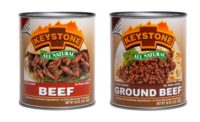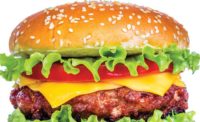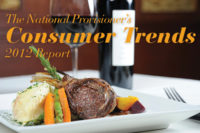Meat and poultry companies are tasked with the increasingly difficult task of providing all the information that a consumer wants to see when making a purchase decision. The problem lies in the fact that consumers want to know more and more about every aspect of animal production and processing, and there is only so much space on the front of a package. To attract customers, companies are developing creative packages that are attractive and informative, while still keeping the food safe.
Del Terruño is a Holliston, Mass. company that imports grass-fed beef from Uruguay. Thanks to the country’s temperate climate, its cattle are able to stay on a grass diet year-round. Del Terruño’s primary customers have been high-end restaurants, but the company is making a push to expand its retail presence as well. Maria Stearns, sales representative for the company, says that it offers full farm-to-table transparency, which matches the desires of today’s shopper.
“Our individual shoppers want to prove to their friends and family that they are knowledgeable about choosing meats,” she says. “They want to know where their food comes from in general and where their beef comes from in particular. Without really wanting details about slaughterhouse etc., they want assurance that the process follows approved guidelines and that the animals were raised humanely and not made to suffer unnecessarily; hence the obsession about “local,” since “local” means nice guys I may know versus huge multinationals with no responsibility.”
To make its consumers comfortable with Del Terruño’s grass-fed beef cuts, beef patties and ground beef, the company puts a QR code on each package. Consumers can scan it with their phones and immediately get a host of information about the animal, including the farm where it was raised (complete with a picture of the farmer and a Google Maps link to the farm’s location). It also verifies the claims that the cattle were grass-fed and given no added antibiotics or hormones.
“You can see which farmer on which farm brought you the delicious cut of beef,” Stearns says of the QR code.
Along with the code and the on-pack claims, all of which were USDA approved, Del Terruño promotes its website to consumers, where the company is able to fully explain its story without the constraints of package size.
As it was entering the retail market, the company reached out to higher-end niche food stores, because those places are where consumers expect to find premium products. Premium products, though, are increasingly becoming mainstream.
“What we see now as a trend is that mainstream grocery stores are trying to appeal to this same shopper and are searching for providers that can supply the volume year-round that we can,” Stearns says.
Selling “just chicken”
For Mary’s Free Range Chickens, a clean-label product is a very personal endeavor. Mary Pitman, matriarch of Pitman Family Farms, says that she battled illnesses for more than 30 years due to a severe intolerance for processed foods.
“The only way I could take care of my boys was to eat protein and vegetables – before they started calling it the Paleo diet. This was before there were Whole Foods Market and Sprouts, so it was very hard to find healthy food back then,” she says.
As an early label-reader, Pitman says she is very passionate about explaining the differences in other products and the chicken her company produces now.
“As I tell people when I’m out doing demos, ‘It’s just chicken. What a concept!’ There’s no 7 to 20% water, because we air chill chickens,” she explains.
Pitman says that shoppers are savvier than ever and have done their research before ever stepping foot in a store. Consumers have even emailed Pitman asking about the type of feed that the chickens are given.
Mary’s Chickens have the Certified GMO-free designation, something Pitman was particularly proud to achieve. Her son, Ben, played an integral role in gaining USDA approval for the Non-GMO Project Verified label for meat and liquid egg products.
“He did all of the writing for them and was teaching them what it meant,” she explains.
Mary’s Chickens and other poultry products are sold at stores like Whole Foods, where consumers seek out attributes like “GMO-free.” The hardest part of adding that claim to the product was getting enough farmers to convert their operations, but the company has found enough consumer demand to make the process worthwhile.
“Every time you go to a store that carries organic you’ll see five or ten more items every couple of weeks. It’s one of the fastest-growing industries in the United States,” she says. “Because I need it for my health — actually everyone needs it for their health, whether they know it or not — I’m very happy that this is changing and I can more easily when I’m traveling find something healthy to eat.”
Eliminating the asterisks
Sierra Meat & Seafood, along with sister brands Durham Ranch and Flocchini Family Provisions, produces everything from fresh meat and seafood for restaurants and institutions in the northern Nevada market to whole-muscle beef sausages for retail. One of its newest products from Durham Ranch is a line of jerky products, including elk, venison, Wagyu beef, wild boar and bison. Tom Ryan, senior vice president of sales & marketing for Sierra Meat, said that the company had offered jerky before, but this new line is a completely new product, with new flavors and formulations.
“The jerky is what we call clean deck, meaning that it has no nitrites or phosphates, and then we go with a softer mouth feel instead of the old days of the jawbreaker jerky,” he says. “We go for smaller pieces, which we find are a little more consumer friendly. There’s enough toothiness that you get that familiar jerky feel, but not so much that you need to visit your dentist.”
Initially, the plan was to package them in clear bags with a sticker label, but consumers in focus groups wanted to know more about the story, so Durham Ranch opted for a printed bag.
“We decided to make the investment in the bag itself and the time to develop bags that are USDA compliant and also are friendly for the average consumer to pull out the specific features and attributes of the jerky that make it special,” Ryan says. “[The new packaging] explains what Durham Ranch is and really gives people a feel that what it is they’re getting is a little different or special.”
When it comes to consumer packaging in general, Ryan says that the company tries to avoid including asterisks and disclaimers whenever possible, to avoid any consumer confusion about the product or the industry.
“I feel like marketers can do the industry a disservice when they claim that turkey or bison or pork is hormone free. It’s illegal to add hormones, so making a claim about that is bragging about something that you should already be doing, and I find that misleading,” Ryan says.
The claims on the Durham Ranch jerks packages break the color wheel, meaning that are specifically designed to catch the shopper’s eye with bold coloring. However, they are not so large as to take away from the things that are most important: the brand and the type of product. The claims are worded to as to be truthful as well as ethically responsible. “Raised without antibiotics” is an accurate description of the way the animals were raised. “No added hormones” is also an accurate statement, and more honest than to say “raised without hormones,” Ryan points out.
In the case of processed items like Flocchini’s sausages, Ryan says that “no added nitrites” and “no added phosphates” are claims that consumers desire. The nitrite-free claim does require an asterisk, though, since nitrites do occur naturally in celery powder and other ingredients.
The premium packaging for the Durham Ranch jerky was an unanticipated cost, but it does complement the premium meat snacks inside. Where its products are concerned, Sierra Meat tries to stay in the premium foods niche rather than battle it out in the commodity market.
“People are going more for the quality side than the quantity side,” Ryan explains. “I believe that they are willing to pay a little bit more per pound for better stuff, and they’re willing to have a little bit less of it since they’re willing to pay more per pound.”










